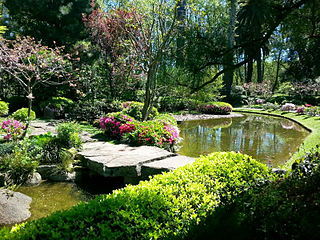
Montevideo is the capital and largest city of Uruguay. According to the 2011 census, the city proper has a population of 1,319,108 in an area of 201 square kilometers (78 sq mi). Montevideo is situated on the southern coast of the country, on the northeastern bank of the Río de la Plata.

The Wollongong Botanic Garden is located in the Wollongong suburb of Keiraville at the foot of Mount Keira in New South Wales, Australia. It is the local botanical gardens of the Illawarra and was established in 1964. It was opened in September 1970.

The Adelaide Botanic Garden is a 51-hectare (130-acre) public garden at the north-east corner of the Adelaide city centre, in the Adelaide Park Lands. It encompasses a fenced garden on North Terrace and behind it the Botanic Park. Work was begun on the site in 1855, with its official opening to the public on 4 October 1857.

The Argentine National Historical Museum is located in Buenos Aires, Argentina, and is a museum dedicated to the history of Argentina, exhibiting objects relating to the May Revolution and the Argentine War of Independence.

Parque Tres de Febrero, popularly known as Bosques de Palermo, is an urban park of approximately 400 hectares located in the neighborhood of Palermo in Buenos Aires, Argentina. Located between Libertador and Figueroa Alcorta Avenues, it is known for its groves, lakes, and rose gardens.

The Parque General San Martín is a park located in the city of Mendoza, Argentina.

Prado is a barrio and a major public park in Montevideo, Uruguay. Together with Nueva Savona, they form the Prado - Nueva Savona composite barrio. Prado is also the name given to all the park areas on both sides of Miguelete Creek, limited by the bridge of Agraciada Avenue over the river to the south and by Millan Avenue to the northeast.

Juan Manuel Blanes Municipal Museum of the Arts is the name of a municipal museum in Prado, Montevideo, Uruguay.

Residencia Presidencial de Suárez y Reyes, or simply Residencia de Suárez, is the official residence of the president of Uruguay, so-called because it is located at the intersection of Suarez and Reyes streets, in Prado, Montevideo. To its back lies the Montevideo Botanic Garden. It was built during the first presidential term of José Batlle y Ordoñez.

A rose garden or rosarium is a garden or park, often open to the public, used to present and grow various types of garden roses, and sometimes rose species. Most often it is a section of a larger garden. Designs vary tremendously and roses may be displayed alongside other plants or grouped by individual variety, colour or class in rose beds. Technically it is a specialized type of shrub garden, but normally treated as a type of flower garden, if only because its origins in Europe go back to at least the Middle Ages in Europe, when roses were effectively the largest and most popular flowers, already existing in numerous garden cultivars.

Tourism in Uruguay is one of the most important facets of the nation's economy.

Juan Manuel Blanes was a noted Uruguayan painter of the Realist school.

National Museum of Visual Arts (Uruguay) a museum in Parque Rodó, Montevideo, Uruguay. It was inaugurated on December 10, 1911.

Cordón is a central barrio of Montevideo, Uruguay, located directly East of the Centro. Its main avenue is 18 de Julio Avenue. It is delimited by Miguelete Str. and La Paz Str. to the North, Dr. Barrios Amorin Str. to the West, Canelones Str. to the South and Dr. Joaquin Requena Str., and Rivera & Artigas Avenues to the East.

Aires Puros is a barrio of Montevideo, Uruguay.

Plaza Zabala is a plaza in the Ciudad Vieja of Montevideo, Uruguay. In late 1878, during the dictatorship of Colonel Lorenzo Latorre, it was decided to demolish the old fort and build a public square in its place. But for 12 years this site remained a wasteland. The Plaza finally came to be established only on December 31, 1890 when the equestrian statue of Bruno Mauricio de Zabala was installed. It was sculpted by the Spanish sculptor Lorenzo Coullaut Valera in collaboration with the Basque architect Pedro Muguruza Otaño and inaugurated on December 27, 1931.

Miguelete Creek is a Uruguayan stream, crossing Montevideo Department. It flows into the Bay of Montevideo and then into the Río de la Plata. It has a very significant history behind, since colonial times.

The Japanese Garden of Montevideo is located in the Prado neighbourhood of Montevideo, behind the Juan Manuel Blanes Museum.

Running Creek is a rural locality in the Scenic Rim Region, Queensland, Australia. In the 2016 census Running Creek had a population of 147 people. It borders New South Wales.

Dumas Oroño was a Uruguayan artist, cultural manager, and teacher. His artistic work spanned several disciplines, including painting, engraving, ceramics, murals, and jewelry design.






















